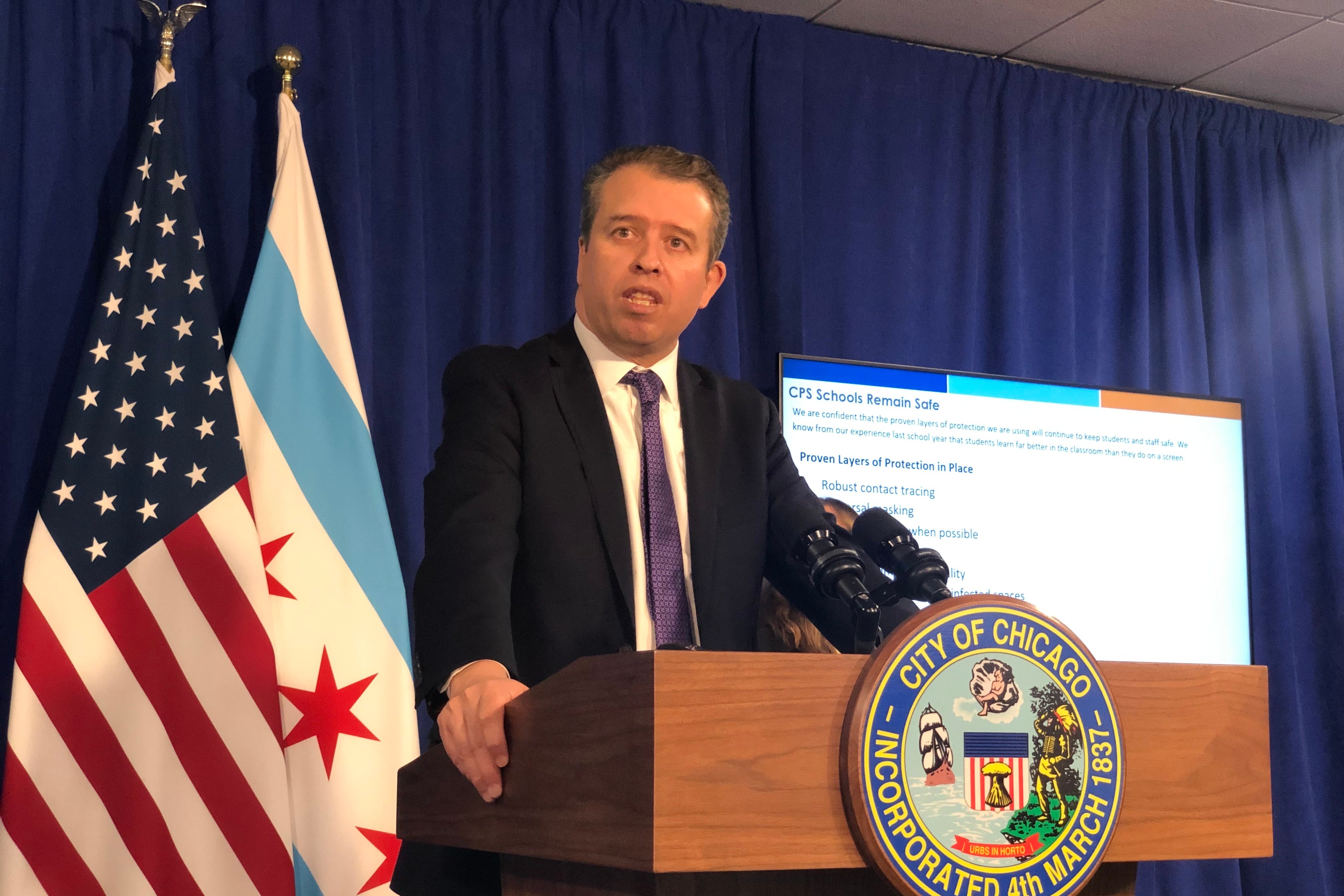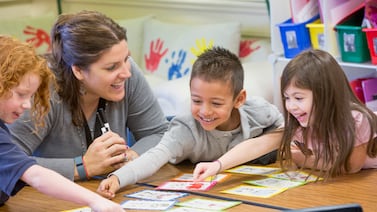Members of Chicago’s teachers union were voting Tuesday night on whether to halt in-person learning after district and union officials could not reach agreement on terms for operating schools as the omicron variant sent COVID cases skyrocketing.
At a news conference earlier Tuesday, Chicago Public Schools CEO Pedro Martinez said the district would agree to additional COVID safety measures, including school-level metrics that would determine when entire campuses close.
The schools chief, however, stopped short of agreeing to at least three key components of the union’s demands: negative PCR tests for all staff, students, and volunteers as well as 300 school-based testing sites; a citywide metric that would pause in-person learning across all campuses; and telework accommodations for staff with medical risks.
In a letter to families Tuesday evening, Martinez said that the district would cancel classes Wednesday for students if educators voted to not report to work the next day.
“If classes are canceled tomorrow,” the letter said, “students should not report to the buildings for in-person learning; remote instruction will not be available either. However, school buildings will be open during regular hours for administrators and staff who are expected to report. Please note that after-school activities, athletics, and any other scheduled events will be canceled as well.”
The union’s House of Delegates voted overwhelmingly to forward to its full membership a measure that would effectively shutter school buildings starting Wednesday until Jan. 18 — unless an agreement is reached. Martinez previously said that school buildings would be open.
“All staff will be welcome to come to school,” he said. “I am not going to let parents down.”
Martinez did not immediately say whether remote learning would commence should the in-person work stoppage extend past a day or whether teachers would be locked out of virtual classrooms moving forward.
The district’s latest proposal, which also includes the immediate distribution of 200,000 KN95 masks to staff to “reduce anxiety” and reactivation of health screeners at the door for students at some schools, is a last-minute effort to avoid a vote that would impact 330,000 students.
Martinez made a public plea Tuesday to keep schools open, saying the evidence shows schools are safe. He said the district is “committed” to reaching an agreement.
“I’ve been to the schools. Our children are wearing masks. They want to be there; they want to be there in person,” said Martinez, who said he visited six schools Monday and remarked that some had low attendance since families are afraid, while others appeared full.
Chicago Public Schools could not provide a student attendance figure for Monday. A spokeswoman said that 82% of teachers reported for work at classrooms on Monday, the first day back after winter break.
Martinez, who started the job in late September, is trying to reassure parents that schools are safe and to de-escalate tensions with a teachers union ready for action. Unable to get district leadership to agree to a slate of safety measures and to sign a reopening agreement it has pushed for since last summer, the union has been galvanized by climbing COVID rates and staff shortages and is planning a meeting of its House of Delegates later Tuesday afternoon.
Unless Martinez’s administration can speed up negotiations and come closer to an agreement that includes thresholds for when to close schools should COVID cases rise, the delegates will weigh a resolution calling to pause in-person learning. That resolution, if passed, would then go to the rank-and-file to ultimately decide in a fast-turnaround evening vote.
The resolution calls for the in-person work stoppage to start as soon as Wednesday, leaving parents and families with little notice.
During the 2019 teachers strike, when educators voted on a work stoppage, the district reopened schools with limited staffing by administrators and central office personnel for families that needed child care. But most families kept their children home.
Martinez said Tuesday “it’s not practical” for the union to call a citywide in-person work stoppage and that he had met with union leadership Monday in an effort to reach an agreement. He said parents would be notified of a plan later in the day and that school Wednesday likely would be impacted.
Among the additional safety measures proposed is a reactivation of online health screeners — but that would be up to school discretion in the district’s latest plan. The district previously required parents to complete health screeners each day when it reopened schools last spring, but stopped using them this fall. Some educators complained that they caused logistical issues in the morning since not all parents complete them.
The teachers’ threat of an all-remote vote comes as Chicago reports its highest daily case rate since the start of the pandemic, and as the city’s positivity rate reaches heights that mirror the first surge in 2019 — a scenario playing out in cities across the country. Numbers released Tuesday by the Chicago Department of Public Health put the city’s test positivity at 23.6%, up from 17% last Friday.
More children have tested positive for COVID as the city’s positivity climbs, Dr. Allison Arwady, the city’s health commissioner, said Tuesday. She said the rising rates were fueled by holiday gatherings, not school reopening.
“Child COVID hospitalizations remain very rare,” at about seven per day for children, said Arwady, with most hospitalizations still driven by unvaccinated adults. She said Tuesday that, since Thanksgiving, no vaccinated children between the ages of 5 and 11 have been hospitalized in Chicago and that nearly half of the child hospitalizations were unvaccinated 12- to 17-year-olds.
The coronavirus was behaving like the flu among children and Arwady remained “comfortable” keeping kids in schools.
The city has struggled to boost its childhood vaccination rates, though Chicago’s rates are higher than the national average. Currently, 34 % of 5- to 11-year-olds have at least one dose and 62% of 12- to 17-year-olds have completed the series.
Arwady said Tuesday that she’s worried what will happen to children should schools shutter in-person learning. “I understand that people are scared, but I want to reassure you, especially if your child is vaccinated, this is behaving like the flu, and we don’t close school districts for extended periods of time for the flu.”
Under the district’s Tuesday proposal, any school would transition fully to remote learning if 40% or more of its classroom teachers are absent due to COVID-19 for two consecutive days or if a schoolwide teacher absence rate remains at or above 30 %.
Schools could go remote if 50 % of elementary school classrooms have more than 50% of students isolated or in quarantine. It would take more than 50 % of the total student population to shift a high school.







